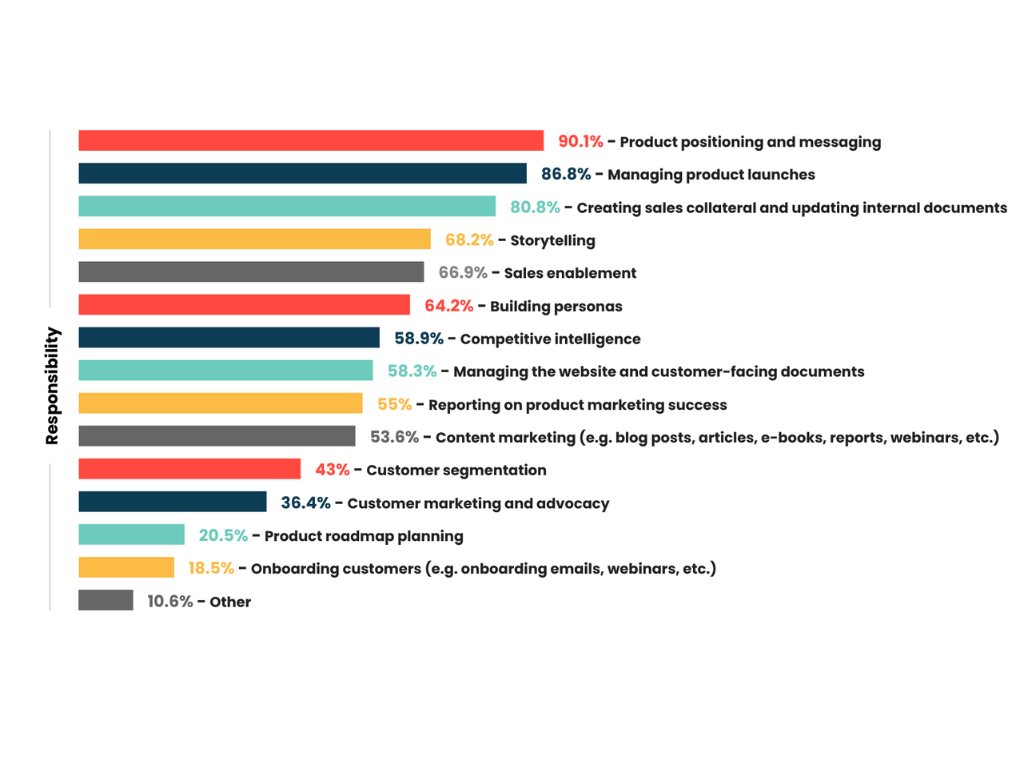While it’s satisfying seeing your product sit pretty on the shelf after months of refining personas, selecting the right pricing strategy, and planning for potential barriers, there’s one thing, and one thing only that’ll make the top brass sit up and take notice.
Cold, hard sales.
If you’ve burned a small hole in the pocket of company stakeholders, you can bet your bottom dollar they’ll wanna see tangible results post-launch, otherwise, you could be in for a scalding.
Putting the relevant sales enablement plans in place for your sales team to tackle their role effectively is critical in helping your reps optimize their performance, and show you the money.
Jerry Maguire style. 💰
In this guide, you’ll learn quite possibly everything you need to know about sales enablement, including and not limited to:
- What sales enablement means,
- Why sales enablement is important,
- What a sales enablement person does,
- How you can get support for sales enablement,
- What a sales enablement strategy is,
- How you can measure sales enablement success,
- Sales enablement platforms and tools,
- The difference between sales enablement and marketing, and
- How you can get into sales enablement.
Unlock our sales enablement resources here. 👇

What is sales enablement?
Sales enablement is the process of providing a sales team with the necessary tools and resources to help them effectively sell your product to prospective customers and close more deals.
What is the objective of sales enablement?
The purpose of sales enablement is to ensure that your sales team has all the appropriate resources needed to sell products or services to prospects. In other words, it's all about empowering sales reps with the right knowledge, skills, and collateral, so they can have more effective and productive conversations with potential customers.
The success of a sales enablement program can be measured by considering "rep readiness", as well as by examining uplifts in productivity, win rates, and revenue growth.
In short, the objective of sales enablement is to onboard, inform, educate, and motivate members of the sales team in an effort to drive more revenue.
What are the components of sales enablement?
There are five important components to a sales enablement strategy that are useful in equipping sales professionals throughout the sales process. These are:
- Sales training/coaching
- Content/assets
- Sales enablement solutions/tools
- Strategy
- Metrics
Throughout this guide, we’ll cover each of these components in more detail. Let’s begin with sales enablement assets.
Sales enablement assets
A company’s weapon of choice will vary, depending on its product, industry, and market, and there are an array of sales enablement assets available to drive organizations towards their end goal, including:
- Battlecards - short, snappy, to-the-point sales docs documents designed to help your sales team gain a firm understanding of a rival’s strategy, as well as key sales messages, essential info about your product, and value propositions to oust the competition.
- Sales script - Say ta-ta to the days when your reps are tongue-tied when you’re speaking with a prospect. Sales scripts provide the perfect opportunity to equip your team with a set of talking points and guidelines to help them navigate the trickiest of scenarios.
- Sales one-pager - As the name suggests, a sales one-pager is literally a one-page document providing an overview of a product, service, or business.
- Product sheet - A product sheet serves as a reference point for sales teams if they’re asked to explain a product’s or service’s more technical features.
Sure, the benefits of these resources stretch far and wide, but the key is nailing yours down to a T so they’re uber useful for your team.
To help you with things like battle cards, sales scripts, and sales one-pagers, we’ve put together a bank of editable templates and frameworks to make your life much easier, for PMA members and PMMs who’ve either enrolled in our Product Marketing: Core [On Demand] course, or Product Marketing: Core [Live + Online] accreditation.
Why is sales enablement important?
There are so many benefits of sales enablement, and advantages to adopting a sales enablement strategy for your business. The main one is that it’s an opportunity to revolutionize your selling technique, bring in more customers, confidently help customers through the buyer’s journey, and rake in increased revenue for your organization.
Why do you need sales enablement?
But that’s just one reason. Let’s take a closer look at how this technique can help your product marketing function.
An opportunity for collaboration
In the State of Product Marketing Report 2023, we found that 80% of product marketers were responsible for creating sales collateral for their organization, an increase from the 2022 report at 78%. In the same report, when asked which team(s) they worked most closely with, the results showed that 75% of product marketers worked closely with sales.

Helping your sales teams improve their technique will only improve your relationship with them and allow them to help you out more in the future when creating or sharing sales collateral, and so on.
Help to hit more KPIs and sales goals
It’s important to increase your knowledge on how to enable sales teams to become the absolute best they can be. It’ll help you to improve, refine, and increase the number of customers they bring to the organization, how many products they sell, and ultimately hit more sales goals. These steps will only benefit you and your company in the long run.
Increase customer and competitive insights
Sales teams are constantly on the frontline, talking to prospective customers and discovering the characteristics that are beneficial to know when marketing to them. If you actively work towards improving your sales team’s approach to selling products, in turn, they can help your team with the insights and data they gather from their sales calls.
Through these sales calls, you can gain a deeper understanding of your prospective customers, including their pain points, how they like to be spoken to, and so on. They can also help to gather more information about your competitors from what your potential customers are saying about them. For example, the product features they prefer, pricing and discounts, etc. These insights in turn will improve your product marketing approach. It’s a win-win!🏅
A fresh perspective
While sales and product marketing are working on similar aspects of the industry within their respective roles, understanding how the sales teams work will give you, as a product marketer, an opportunity to learn different ways to sell to the same customers.
What does a sales enablement professional do?
A sales enablement manager is responsible for ensuring that the sales team is equipped with all the tools, content, knowledge, etc needed to confidently carry out sales calls and processes.
So, their job is to create training programs, sales content and assets, research effective tools and platforms, and share sales best practices that the whole team can share and use to optimize their approach, bring in profits, and confidently help prospective customers through the customer journey.

How do you get support for sales enablement?
There are plenty of times when a product marketer believes introducing sales enablement initiatives will be the best thing since sliced bread.
But before you can begin planning anything, you need to have the powers that be on board, as is the case when building a business case for a new product.
Sure, you may see the many benefits of using sales enablement assets, but if your stakeholders aren’t on board with the idea, you’ll sink, rather than swim.
Here’s how you can present your case effectively and get the nod to begin your sales enablement efforts:
Evaluate your organization’s requirements
This may seem fairly obvious, but we don’t apologize for starting with the bare basics; if it wasn’t necessary, we wouldn’t include this step at all.
It’s important to establish what success will look like in terms of sales enablement at your company - what do you want to accomplish, and which problems could this solution if it’s successful?
Remember, clarity and confidence are key when you’re pitching an idea or suggestion. Enter your meeting with clear goals in place to be sure you can focus your budget requests, and put every possible measure in place to get an understanding of facts that can solidify your case for introducing sales enablement.
Some might say curiosity killed the cat, but we say ask plenty of questions and seek advice from people who can give you the steer you need. For example, if the reps in the sales department aren’t cutting the mustard, buddy up with sales ops and find out why. This could highlight areas where you can place particular emphasis.
Add to that, stone-cold evidence gives you credence and highlights why they need it in place; companies willing to invest in sales enablement tools because you assure them how awesome it’ll be are as rare as an eight-legged unicorn.
Look at the requirements. Seek evidence.
Don’t get giddy and go all guns blazing.
Strategize
So, you’ve got the problem fixed firmly in your sights. Now, it’s time to plan a solution, and a sales enablement charter is used as a means of presenting your plan to execs; consider it a sales enablement equivalent of business case messaging.
Your charter needs to provide decision-makers with the information they need to make the final decision, including:
- What the program’s responsible for,
- How it’s going to be staffed,
- Target audience,
- Key investments,
- Which metrics will measure success?
Speak the local’s lingo
Imagine an Apple sales rep selling their latest mobile phone to a tech-savvy buyer. They needn’t dumb down the jargon for fear of confusing the interested party; they can go about their business naturally and use every acronym and technical term under the sun.
On the other hand, if a technophobe entered the store and asked about the same product, the rep would have to change their approach and simplify the explanation previously given to the more adept buyer to close the sale.
In the same way, reps need to communicate clearly with their customers, the same logic applies when you’re trying to convince internal teams to buy into your sales enablement proposal. Use your charter to demonstrate how passionate you are about bringing this to life, and how much you think it'll improve the services being offered.
After all, when it comes to the crunch, if you can show your idea has financial legs, the likelihood is they’ll run with it.
To have them eating out of your hand, rather than chewing you up, communicate your messages clearly, and highlight how they’ll be the beneficiaries of your suggestions. Also, tailor your plan to the priorities of the company, if possible. So, if the CEO has made it clear they’re keen to increase customer retention, specify how the plan will address how account managers can improve the renewal process.
Get the support of the wider network
It’s not just the support of stakeholders you’ll need to begin your sales enablement quest. Sales reps and their managers also need to buy into your pretty plan, and to get them on the side, you need to understand their requirements and let them know what they’ll gain from buying into your proposal.
Focus on the positives; good news will always prick the attention of your audience. So, if you’re speaking with sales representatives, if there’s a rep who has secured new business following enablement-led training, don’t keep your cards close to your chest, let them know how your plans could help them do the same thing.
As far as your sales managers are concerned, communicate with them regularly, and liaise with front-line leaders throughout your push for new initiatives.
How to measure sales enablement success
Let’s face the facts: there’s zero point in putting in all of this hard work if you don’t know whether it’s been worth the effort.
There’s a simple solution on the table that’ll let you know whether your master plan has been a resounding success, or somewhat of a disappointment.
OKRs, objectives, and key results are commonplace for sales teams, there are questions you can pose to your reps that’ll allow you to assess what’s working, and what isn’t.
Need a hand getting started putting OKRs in place? Download our free eBook - we’ve got you covered.
How do you build confidence in a sales team?
A sales rep with confidence is like a runaway train - it’s pretty hard to stop. The more confident they are, the better equipped they are to bring home the bacon. So, it’s important to empower your sales leaders, and even your marketing teams, with sales enablement best practices so they can improve their sales performance, and improve their win rates.

Put yourself in the shoes of your representatives, for a sec; if you were responsible for selling a product with little to no experience of what it is, how it works, and how it differs from your competitors, would you seriously be rollin’ into the office with a swagger and spring in your step?
Never underestimate the impact confidence can have within your respective teams. Throw yourself whole-heartedly into the sales enablement process and provide your team with the tools they need - believe us, their confidence will sky-rocket.
Battle cards are just one of the many tools you can provide your sales reps as part of your sales enablement process. But how can product marketers create battle cards that are useful, and that their team will use, continually?
Follow the link below to find out more.


In addition to battle cards, there are several other sales assets you can introduce to inject some zest into your team, to help them turn mere prospects into bona fide customers.
These resources differ, depending on whether they’re being used externally or internally. So, without further ado, let’s check out the options at your disposal, shall we?

How do you excite your salespeople?
Salespeople are a fundamental part of the overall success of your product; they’re the ones who’ll be speaking to your customers and trying to push the sales over the line.
We’ve all been in a scenario where a sales rep lacks verve, and panache, and are quite frankly, dull as dishwater - it’s a huge turn-off, and can prove to be the deciding factor in a prospect downing tools and having a nosy at your competitor.
This is why you need to pull out all the stops to get people uber-excited about your launch. Enthusiasm is contagious; in the same way, your customers pick up on a lack of enthusiasm, they’ll lap it up when the person at the end of the phone is demonstrating a genuine interest in not only the product they’re selling but the person on the other end of the phone.
It’s all well and good saying what you need to do, but the question you’re bound to be interested in is how do you get salespeople excited about your launch?


Selling with humor
Some might say when sales reps let their masks drop, they’re leaving themselves open to being walked all over by a prospective customer.
From our perspective, this philosophy isn’t true, by any means. Sure, there may be times when making jokes left, right, and center may not necessarily be the best approach to take, but there’s certainly a spot for encouraging your reps to inject an element of humor into their style.
When you’re speaking with a prospect, they’re much more likely to do business with you and your team if they like you - so what better way to get on a person’s good side than making them smile?
Comedians within the community will be pleased to know we’re not alone in promoting a happy-go-lucky style to your sales dynamic. Rebecca Geraghty, Director of Product Marketing at Publicis Media has previously outlined how comedy can impact sales enablement and prospecting.

What is a sales engagement strategy?
Sales engagement refers to the interactions that occur between a salesperson and a prospective customer throughout the sales cycle until they close the deal. This could be through meetings, sales calls, email click-through rates, e-book/playbook downloads, and so on.
So, a sales engagement strategy would be the approach your sales team members take to actually have these interactions with the customer and increase the number of interactions that occur.
What is a sales engagement process?
A sales enablement team will often develop a sales engagement process for the sales team to follow so that there’s more structure to their sales strategy. This is with the hope that the sales cycle runs more smoothly, and ends in a closed deal.
A typical sales engagement process will have a set of stages, similar to this:
- Planning: Gathering the sales team to see how the sales engagement process should be approached.
- Prospecting and research: Time to identify prospective customers, research them to build strong personas, and add them to the database.
- First contact: This is the outreach stage, but shouldn’t be with the focus of closing a deal. This is to nurture any potential relationships with your prospective customers, teach them about the product or service that your company provides, and get that initial link of interest.
- Lead nurturing: This is where you begin to really develop those relationships with the customers you first reached out to, with the hope of leading them through the sales process and getting a closed deal. You can do this through follow-up calls or emails, answering any questions they may have, and essentially supporting them so they feel more comfortable and connected with your organization and solution.
- Closing the deal: As it says on the tin, hopefully by now the first four stages have been successful, and you should be moving on to closing the deal with your prospective customer. It’s important that this entire process isn’t forced, and that both ends are feeling happy with the deal that has occurred. This leaves the potential for a longer relationship between both parties.
Best practices for sales engagement
Successful sales enablement is when your sales teams use the correct marketing content to improve the sales communication, and ultimately lead the sales engagement in a way that gets them to the end of the sales funnel, and closes the deal they’ve been working so hard on.
Use your resources correctly
To get the most out of the sales engagement process, you must remember to keep on top of your content management, publishing, analytics, sales training, sales operations, and so on. This way, you know you’re using the correct channels and measuring the success of the approaches you take to close the deals effectively.
Providing the sales team with the relevant content, whether that’s whitepapers, one-papers, battle cards, or playbooks is essential to keep the prospective customer interested, and provided with information so they can make the correct purchase decision.

Develop your personas or ICPs
But, it’s important that you’re using the right content for that particular prospect, which is where developing personas or ICPs (ideal customer profiles) come in.
A great way of developing these personas is through social media, like LinkedIn, Twitter, online forums, review sites, and so on, to see the kinds of conversations they’re having, what kind of information they seek about similar products, how they like to be communicated with, and so on.
Use the correct channel
Along with the correct resources, the prospect is going to have a particular preference for communication. This is where your personas, or ICPs, will come in handy.
Time your communication correctly
Another important factor in a strong sales engagement strategy is well-timed communication.
For example, you discover they don’t like communicating through calls, so you put a form on your website they can fill out requiring certain pieces of information. Then, it takes you over a week to get back to them. By then, they’ve likely already found another option. So, you’ve picked the correct channel, but timed it incorrectly.
So, you need to ensure that your team’s response times and sales productivity are up to speed by analyzing your prospect’s availabilities, the average times where it’s busiest, and so on, and adapt your engagement strategy to meet their availability and timing.
Best practices for sales enablement
Roopal Shah, Head (VP) of Global Enablement at Benchling, shared her best practices for sales enablement in her presentation for the Masters of Product Marketing event in October 2021. Catch up on the presentations from this event using our OnDemand service.
For now, this is what she had to say:
Make it fun and entertaining
“Learning cannot be boring, and frankly, we're just too busy to keep it like that. How are you going to get your content across to your sellers? Videos? Cartoons? Costume simulation? How are you going to make them want to take your sales training and learn in the process, rather than just checking a box? Think about entertainment, not just education.
Flipping the classroom
“The idea here is that the classroom can become a more engaging, interactive experience, rather than me just talking at you for 15 minutes. This is true whether it’s online or in-person.
“You don’t have to rely on recordings. It can be articles, it can be blog posts, it can be whatever you need for them to come in with as much context as they can have. The important thing is that they’re able to apply it. When they come into the virtual session, they already have a lot of contexts.
“When you get your breakout rooms set up, have your product evangelists be in each of them. Get in those breakout rooms yourself. You're there to really ask thought-provoking questions and prompt them and get them to think about this. You want to ensure you’re getting feedback as well. Is your messaging resonating? It's a great way to get on-the-scale feedback from various folks in your sales team.
Gamification
“As you're thinking about working with your enablement team and thinking about how to get content to stick, you really need to think about gamification. Whether it's competing teams with prizes and rewards, the important thing is that your team is having fun. Prizes show that you are celebrating that learning. It also gives positive reinforcement to those who have done good work.
“Ultimately, organizations that have done this have better seller engagement. If your sellers are engaged, you're more likely to have your sales move forward. My final takeaway: Don’t just focus on customer or buyer engagement, focus on seller engagement.”
How can you measure sales enablement success?
As is the case with any process, if you’re putting in the legwork to set the ball rolling, you’ll want to make sure it’s worth the effort, right?
Sales enablement falls into the same category. After all, if your sales team’s conversion rates remain the same (or heaven forbid, decrease) after your sales enablement intervention, then there’ll be plenty of questions that’ll need answers.
Kelly Esten, VP of Product and Partner Marketing at Toast, gave her insights on effective sales enablement tools, measuring the effectiveness of sales enablement, amongst other useful snippets of expertise, all of which you can check out right here.

What are sales engagement platforms and tools?
Ever tried making an omelet without eggs? Suffice to say, it’s a complete waste of time.
The same logic applies to sales enablement and sales enablement tools - to execute the sales enablement process successfully, you need to have the appropriate resources in place.
Sales enablement tools are platforms and systems designed to give visibility across the sales content lifecycle; they close the loop between marketing, sales, and customers, to help teams track content performance, from publication to pitch.
For instance, SalesLoft is an ideal sales enablement tool for people on the lookout for templates and support with A/B testing, while Gong gives businesses clarity on any areas failing to convert, so necessary amendments can be made.
There’s no end of nifty tools product marketers can use to improve their sales enablement.
What is the difference between sales enablement and marketing?
Often, content marketing (not just marketing) and sales enablement are confused. This is because both teams create content, but on different levels, and for different audiences.
Content marketers create external content specifically for the consumer in order to sell specific products. However, sales enablement creates content and assets for internal use - specifically for the sales team, so they can effectively sell products or close deals with prospective customers.
Is sales enablement part of marketing or sales?
Product marketing sometimes takes on the responsibility of sales enablement when there’s no SE team, but the whole purpose of sales enablement is to help the sales team feel confident in their knowledge, tools, and resources to effectively carry out their sales process.
Because of this, oftentimes, sales enablement is referred to as “the bridge between marketing and sales”. However, it’s not actually either, because it’s its own role, with its own responsibilities.
What is the difference between sales enablement and sales engagement?
The difference is rather simple.
Sales enablement: The process of training and providing resources to your sales teams so they can have the best interactions with their customers possible.
Sales engagement: The interactions between the salesperson and potential customer.
How do I get into sales enablement?
There’s a fair chance you may be reading saying to yourself: “Do I need to introduce sales enablement tools?”After all, your sales figures may be through the roof, right?
As we often say, you’ve gotta ask questions to get the answers you’re looking for. And we aren’t in the mood for bucking the trend yet. So, if you’re unsure whether sales enablement tools are needed at your org, consider:
- Are you hitting your sales goals?
- Can you say with confidence your reps are always on-message?
- Are you positive reps are using sales tools to their full potential?
- Can you improve seller quota attainment?
Answered ‘no’ to any of these questions? Then it’s time to put on your thinking cap and consider the most suitable sales enablement tools for your company.
You may have answered every question with a resounding ‘yes’ and think you’ve passed our test with flying colors; we hate to rain on your parade, but this isn’t necessarily the case - businesses change like the weather, and your situation today could be completely different tomorrow.
For example, if you make additions to your sales team or sales organization, you may need to formalize your onboarding process. Perhaps your reps have been tasked with selling an ever-changing product or service, in which case, the buying process could become more complicated, or your messaging or go-to-market strategy may be revamped.
The aforementioned scenarios aren’t far-fetched, or beyond the realms of possibility; every instance is often faced by companies at some point. Having the appropriate sales enablement software in place can work wonders for companies seeking to maintain sales figures during a transition period.
Still not 100% convinced? By completing a sales enablement scorecard, you’ll get a concrete idea of how strong your current sales enablement setup is.
What skills do you need for sales enablement?
There are a lot of hard and soft skills you need to effectively carry out the sales enablement role. Here, we’ve highlighted four of the most common and important skills you’ll need.
Knowledge of sales processes and methodologies
It makes sense that if you’re going to be the ‘go-to’ person for the sales team to learn about how to successfully close deals with their customers, you must be knowledgeable of the sales processes and methodologies.
You need a level of expertise that you’re going to bring to the role in order to fully support your sales teams. So, ensure that you have a strong knowledge within this area so you can effectively carry out your sales enablement.
Collaboration and communication
A large part of the sales cycle is being able to communicate effectively with the customer, or prospective customer. After all, poor communication can be detrimental to closing deals.
You must have strong communication and collaboration skills with your sales team that they can then transfer into their own roles so they can successfully carry out their sales calls.
Tech-savvy, with a wide range of knowledge in SE platforms and tools
Having a suitable and strong tech stack is another critical asset to the sales enablement role. It’s up to the sales enabler to be able to teach sales teams which platforms and tools are the most successful solutions for the sales process, and how to use them correctly for the best outcome.
Part of the sales enablement role is to also continue reviewing and auditing the tools and automation platforms, keeping them up to date with the new integrations and functions that occur within the market, and continue to find new emerging technologies that would help to improve the competitive advantage of your organization.
Metrics/data-driven
Another part of the SE role is to demonstrate the impact of their efforts through the use of quantitative data.
Through methods such as win/loss analysis, they’ll be able to tell how successful their efforts are, understand how they can close more deals, and essentially optimize and streamline their entire approach to sales and sales enablement.
Project management
As a sales enablement manager, you’ll be in charge of many projects, and you’ll need to oversee their implementation. You’ll also be responsible for the sales team and how they carry out their sales processes, meaning you must be able to strategize with them in order to receive the highest impact and success rates.
So, it’s important to be strong in your project management and organization skills to effectively carry out your sales enablement processes.
How do you learn sales enablement?
How does anyone learn anything?! Practice, practice, practice!
To make things easier for you, we’ve got the perfect solution.
Enroll in our Sales Enablement Certified: Masters course and gain key knowledge needed to launch powerful sales enablement programs.
Join highly-distinguished sales enablement expert Sapphire Reels, Director of Portfolio and Integrated Marketing at Pluralsight, and discover how to:
👊 Convey the importance of sales enablement and sell it to key stakeholders.
🔥 Design a sales enablement program from scratch in line with business objectives and sales needs.
🚀 Launch and iterate on sales enablement programs.
🤑 Communicate the impact of sales enablement on the business and revenue generation.
Refine your strategiesSales enablement templates
We’re always looking for ways to make a product marketer’s life as simple as possible, and you’ll be pleased to know we haven’t bucked the trend where sales enablement is concerned. Here is a collection of resources you’ll have at your disposal with a PMA membership plan.
Battle card template
Although your battle cards will be specific to your business and product, our editable template includes the key components of an awesome template.
Customer case study master list
Customer case studies are like gold dust for your company’s sales enablement efforts; they provide you with the opportunity to showcase the raving reviews of customers who’ve bought (and loved!) your product. With this in mind, you’ve got to ask the right questions and make the most of the opportunity. Enter our list of 80 questions to choose from. 😉
Sales script templates
Similarly, the same dynamic applies when you’ve finally managed to get hold of a lead or prospect; the last thing you need is your sales reps to fluff their lines and let a golden opportunity slip, which is where a sales script can come in handy.
Sales one-pagers
Add our sales one-pagers to the mix, and you’ve got a recipe for red-hot reps, if we may say so ourselves.


